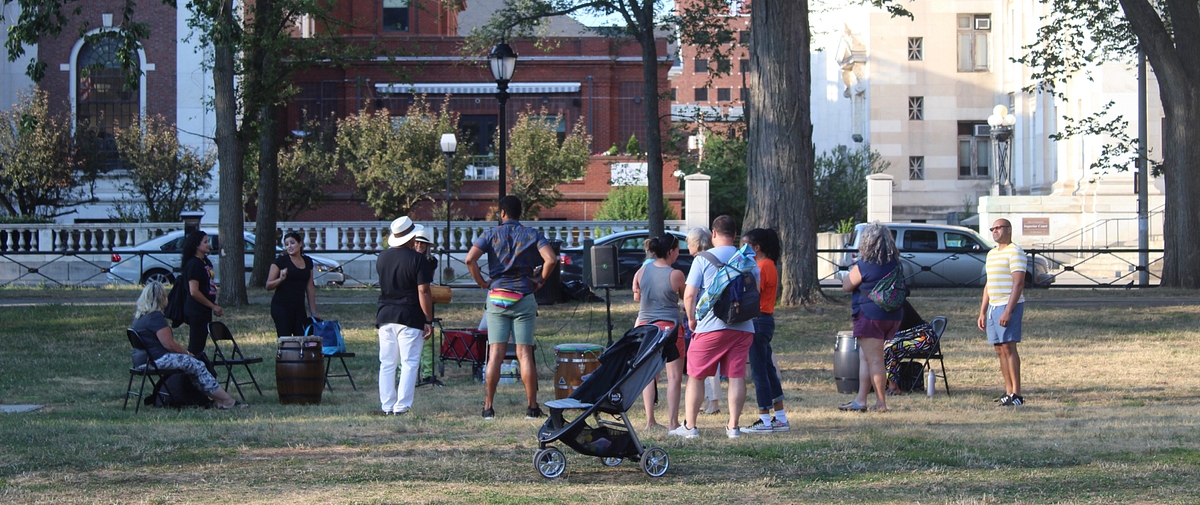
On Friday evening a group of percussionists gathered on the north end of the New Haven Green. They were mostly members of the bomba group Proyecto Cimarrón, and they were there to play for the community — and honor a musical luminary who, just before coming to the Green, gave them a lesson in the heritage of the music they were playing.

Cepeda (at left).
The luminary in question was Jesus M. Cepeda Brenes, and in the world of bomba, he is a master, earning the title Tambor Mayor (“greatest drummer”). As detailed in Güiro y Maraca, a publication of the Segunda Quimbamba Folkloric Center, Cepeda was born in Puerto Rico in 1950 and began learning bomba drumming from his father, bombero Rafael Cepeda, at the age of 5. In his lifelong career as a drummer and drum maker, Cepeda has brought bomba to stage, screen, concert and classroom, connecting the music to its past and passing it on into the future.
“Whether it’s celebrating the abolition of slavery in front of a camera crew from an early morning TV news show, using a bomba and plena music festival to highlight prominent Black professionals, or directing a bomba themed musical production on a stage more accustomed to operas and zarzuelas, Jesus Cepeda finds ways to connect Puerto Rico to its Blackness,” wrote Juan Cartagena in Güiro y Maraca. As a performer, he is “simply indomitable,” his “effortless big sound, punctuated constantly by his mannerisms, fills the stage.” He has also made a huge mark as an educator in “his ability to teach bomba, especially, to hundreds of Puerto Ricans on both sides of the ocean. His work in the United States … in the late 1990s was instrumental to many aspiring percussionists. And his work in the island with the new generation of bomberos and pleneros is even more important.” As Jerry Ferrao, musician and student of Cepeda’s put it, “Jesus Cepeda is one of the better known folklorists of our times in the area of both bomba and plena of Puerto Rico. His contributions have greatly supported folkloric music.… Jesus Cepeda is a bridge between Rafael Cepeda and today’s younger generation of bomberos.”

All of this was on ample display on Friday evening, as Cepeda gathered members of the New Haven-based bomba group Proyecto Cimarrón at Citywide Youth Coalition on Chapel Street, to talk about both bomba’s origins in the resistance to slavery and his own familial origins of the music. He began by talking about the basic principles of bomba he learned as a young drummer. The form as he was taught it was a balance of drum, voice, and dance, with a key focus on the conversation between drummer and dancer. He was taught to watch, listen, and then play, and to play then at a steady tempo; too fast, and you could lose the form.

“Men may come and go,” Cepeda said (sometimes speaking through a translator), “but the principles remain.” His father and his contemporaries, he said, taught his generation the fundamentals of “our very own music.” The drums comprised one of the oldest modes of communication around, and with the rhythms, “people could communicate happiness, suffering, and anything else that was happening.” Bomba, in short, was soaked in the experience of life, and was elevated to a form of high art. Cepeda broke down the rhythms, from the buleador, who kept steady rhythm on one barrel-like drum, to the cúa, played with sticks against the side of the drum, to the maracas, to the primo, on another barrel drum, responding to the movements of the dancer.
He went through a series of rhythms for the drummers to try, from a family of rhythms called sicá, to another family of rhythms called yubá. There were more, many more. But the ultimate goal of the music was simple: for everyone to have fun and express themselves, and enjoy themselves in conversation with one another through music and dance — to create a community.
On the Green, with strength and grace, Cepeda demonstrated everything that he had spoken about at Citywide Youth Coalition. He was first presented with citations from the city and state for his mastery of bomba. Then the rhythms began. Voices rose through the thick summer air. A crowd gathered to listen. As each of the dancers in turn entered the circle of drummers and approached Cepeda, el Tambor Mayor locked eyes with them. His face became an expression of intense concentration and pure joy, an energy that each dancer matched. He watched and listened. As soon as the dancer made a movement, he reacted with a decisive sound from the drum. The conversation began, the rhythms from Cepeda’s drum matching the movements each dancer made. Was the dancer leading the drummer, or vice versa? To the viewer, the distinction was unimportant. What mattered was the obvious thrill that passed between them of spontaneously creating art, steeped in centuries of tradition yet happening right now.
Another song began, and the conversation and celebration of cultural roots continued. Perhaps it was best summed up with a refrain from the one of the singers, picked up by everyone in the group: Africa, Español y Taíno / Yo soy boricua / Soy Puerto Rico. Translated: African, Spanish, Taíno / I am Puerto Rican / I am Puerto Rico.




Very cool. I especially like the percussion lines!!